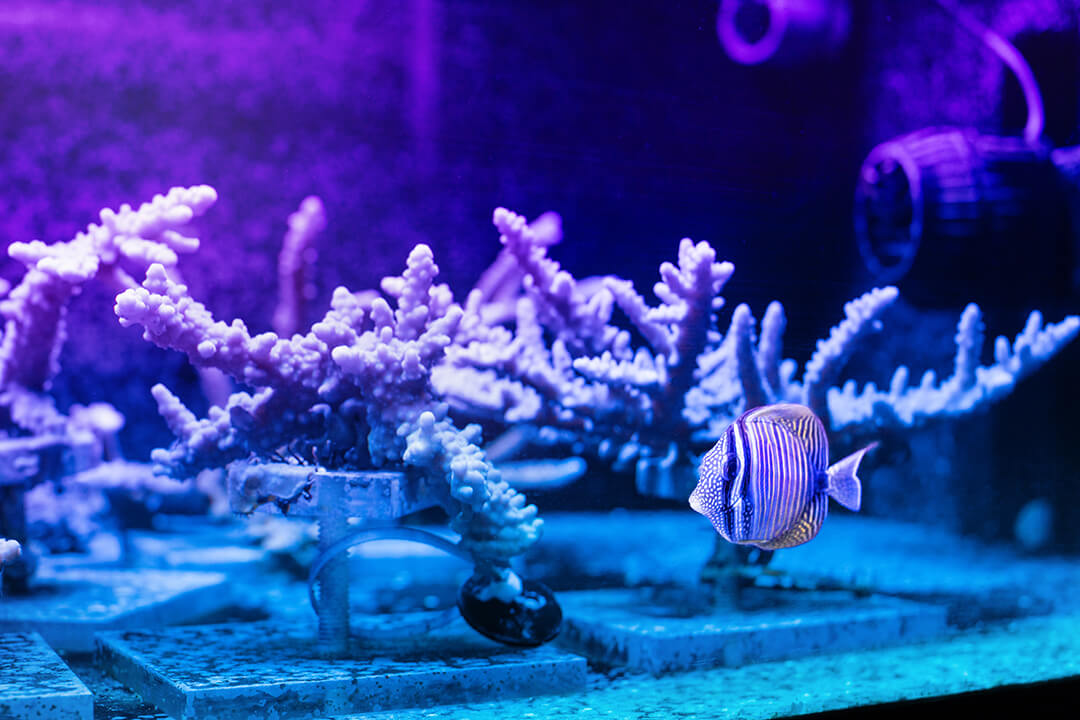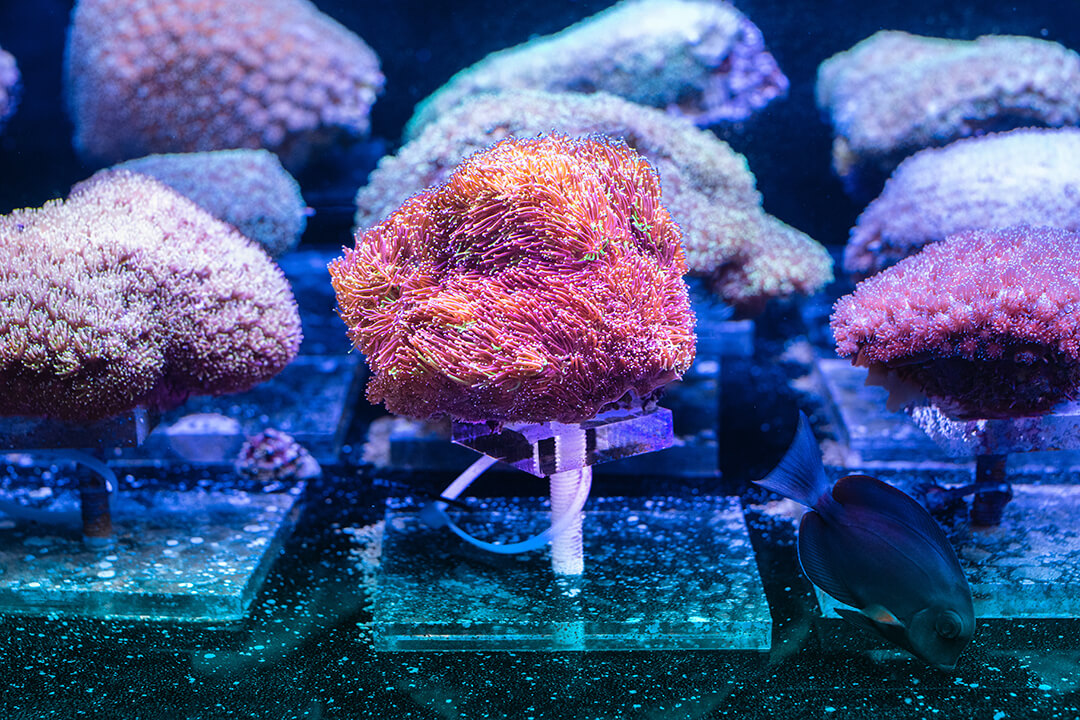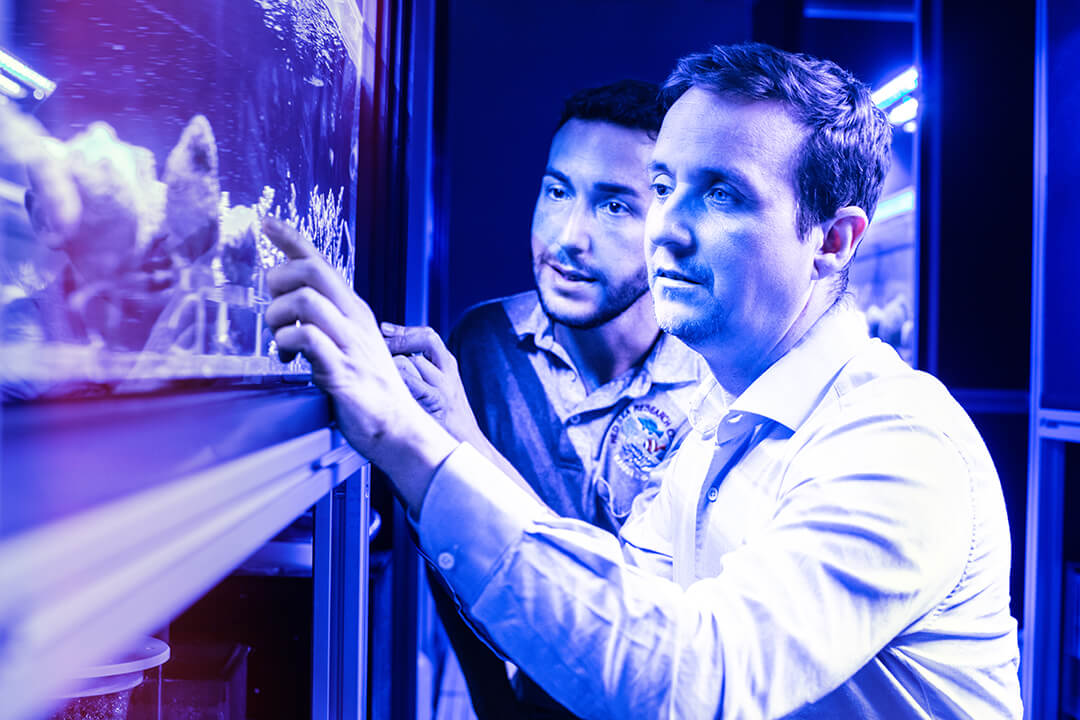Breeding corals throughout the year for their restoration

Corals and a friend in the Core Labs
The world’s coral reefs are dying. The sea has seen half of its coral coverage disappear in the past fifty years, and scientists estimate that the total will reach 90% if temperatures rise two degrees Celsius. The effects are profound, as nearly a third of marine life calls coral reefs home, and nearly a billion people depend on them for their livelihood.
Corals themselves grow through a symbiotic relationship with dinoflagellate algae so essential that they cannot survive without them. The symbionts live inside the coral cells and provide them with enough photosynthetic products to cover most of their energetic needs. Thus, coral reefs flourish, creating the equivalent of an underwater rainforest rich with life. When this relationship breaks down, however, as has been the case with rising temperatures, the corals will purge themselves of the symbionts, replacing their kaleidoscope of colors with a bland white, a process known as coral bleaching. More important, the corals starve and eventually die.
Yet some corals thrive in hotter temperatures, especially those in warmer waters like the Red Sea. Indeed, KAUST researchers such as Prof. Manuel Aranda have shown that some coral species found in the Arabian Gulf are more tolerant of high temperatures than the same species found in other parts of the world like the Indian Ocean. The difference, the researchers have shown, is in their genes. They are therefore mating corals from different parts of the world under the assumption that the offspring will be more thermoresistant than had they been parented only by corals from cooler places.
“A problem we’re facing in our breeding experiments is that coral colonies from different places would usually not spawn at the same time. Using the coral spawning system, however, we can time their spawning to cross colonies that would naturally not cross,” explained KAUST Professor Manuel Aranda about a commercial system in the Coastal and Marine Resources Core Lab (CMR).

One of the coral experiments at the Core Labs
By analyzing the genes of the parents and offspring using the advanced genome sequencing technology at the KAUST Bioscience Core Lab, researchers like Aranda expect to identify and isolate the genes most likely to be responsible for temperature resilience and use this information to “increase the resilience of coral through selective breeding by crossing them with coral colonies from warmer environments,” he said.
KAUST scientists are therefore combing the coral genome, which is about one third the size of the human genome, for candidate genes. To confirm that these candidates give the corals a higher evolutionary fitness, Aranda and his colleagues are using gene-editing technology to knockout the genes and study the effects on the corals. However, these experiments depend on breeding, and most coral species spawn only once a year, giving scientists a short window to collect gametes and larvae for their experiments. Unsuccessful efforts mean scientists can do little more than wait until next year.
Walking through CMR, one finds where the experimental spawning happens. The coral spawning system kept there appears to be little more than a series of large tanks in which someone might keep an impressive fish collection at home. However, it is designed so that the same species can be maintained in waters of different temperature and light cycles. By modulating the temperature and light, Alejandro Prieto, a research specialist in Aranda’s lab, and Hayley Roberts, an aquarist at CMR, trick the corals into spawning at unnatural months. Thus, although a single coral will still spawn just once a year, the same species can spawn multiple times.

Prieto (left) and Aranda observing the corals
Scientifically, these experiments are known as assisted evolution – the artificial acceleration of evolution. They are also the basis for coral reef restoration efforts, be it in Saudi Arabia, such as the KAUST Reefscape Restoration Initiative, which is the largest in the world, or beyond.
Keeping the coral spawning system at CMR was an obvious decision for Aranda. “We could run it in our lab, but it would be much more complicated. CMR provides the space, facilities, and access to seawater,” he said.
CMR also provides invaluable expertise. With her eight years of experience in aquariums, Roberts immediately joined the project with minimal additional training.
“It can take many years to develop the knowledge needed to support corals in such a controlled environment. CMR hires people with these specialized skills to support the many niche research projects of the Red Sea,” she said.
Currently, Aranda’s team is investigating two coral reef species: Acropora hemprichii and Galaxea fascicularis, both of which are found around the Arabian Peninsula, but the plan is to eventually expand to six species. Ultimately, coral offspring with the right genetic fitness will be introduced to seas experiencing rising temperatures as a strategy to protect and restore the reefs.
“Our focus is Red Sea, but we aim to work with researchers internationally so that similar projects will benefit restoration efforts throughout the world,” said Aranda.

